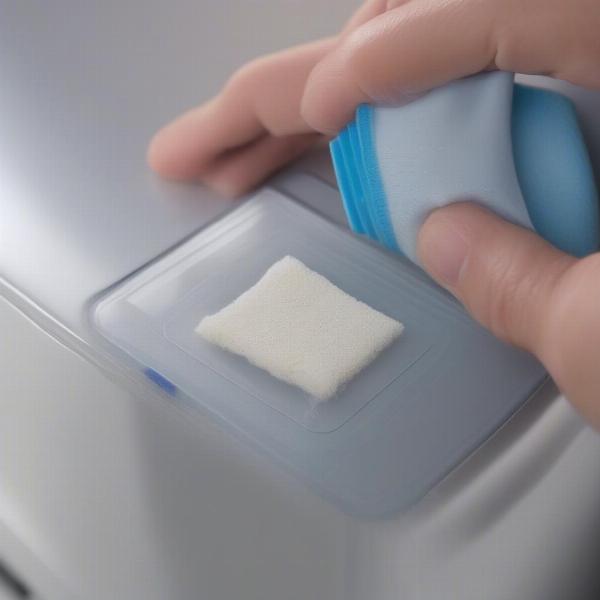Microchip dog flaps offer a smart and secure way to give your furry friend the freedom to come and go as they please. These innovative pet doors read your dog’s unique microchip, granting access only to authorized animals. This means no more unwanted visitors, stray animals, or neighborhood pets sneaking into your home. Let’s explore everything you need to know about microchip dog flaps, from choosing the right model to installation and maintenance.
Choosing the Right Microchip Dog Flap
Selecting the perfect microchip dog flap depends on several factors, including your dog’s size, breed, and the material of your door. Consider the following aspects when making your decision:
- Size: Ensure the flap is appropriately sized for your dog. A flap that’s too small will be uncomfortable, while one that’s too large can compromise security. Measure your dog’s height and width at the shoulder to determine the appropriate flap dimensions.
- Material: Microchip dog flaps are available for various door types, including wood, PVC, and glass. Choose a flap specifically designed for your door material to ensure a secure and weatherproof fit.
- Microchip Compatibility: Confirm that the flap is compatible with the type of microchip your dog has. Most modern flaps are compatible with the majority of microchip types, but it’s always best to double-check.
- Programming Capacity: Consider how many pets you have and choose a flap that can store the required number of microchips. Some flaps can store up to 32 different microchips, making them ideal for multi-pet households.
- Power Source: Microchip dog flaps are typically battery-operated. Check the battery life and choose a flap with a long battery life to minimize the hassle of frequent replacements.
Installation and Setup
Installing a microchip dog flap can be a DIY project, but if you’re unsure, consult a professional. Here’s a general overview of the installation process:
- Measure and Mark: Carefully measure and mark the location for the flap on your door. Follow the manufacturer’s instructions for specific measurements.
- Cut the Opening: Using the appropriate tools, carefully cut the opening in your door. Take your time and ensure the cut is clean and precise.
- Install the Flap: Insert the flap into the opening and secure it according to the manufacturer’s instructions.
- Program the Microchip: Program the flap to recognize your dog’s microchip. This usually involves holding the scanner near your dog’s microchip while pressing a button on the flap.
Benefits of a Microchip Dog Flap
- Enhanced Security: Only your pet can enter and exit, keeping unwanted animals out.
- Convenience: Your dog can come and go as they please, giving them more freedom and independence.
- Peace of Mind: You’ll know your dog is safe and secure, even when you’re not home.
- Improved Energy Efficiency: Microchip dog flaps help to prevent drafts and maintain a consistent indoor temperature.
Maintaining Your Microchip Dog Flap
Regular maintenance will ensure your microchip dog flap continues to function properly.
- Battery Replacement: Replace batteries as needed to ensure the flap continues to operate smoothly.
- Cleaning: Regularly clean the flap and surrounding area to prevent the build-up of dirt and debris.
- Inspection: Periodically inspect the flap for any signs of wear and tear and address any issues promptly.
 Cleaning a Microchip Dog Flap
Cleaning a Microchip Dog Flap
Are Microchip Dog Flaps Worth It?
For many pet owners, a microchip dog flap is a worthwhile investment. It provides a secure, convenient, and energy-efficient way to give your dog the freedom they deserve. While the initial cost might be higher than traditional flaps, the added security and peace of mind often outweigh the price difference.
Conclusion
Microchip dog flaps are a fantastic solution for pet owners seeking a secure and convenient way to manage their dog’s access to the outdoors. By choosing the right flap and following proper installation and maintenance procedures, you can ensure a seamless and enjoyable experience for both you and your furry companion. Remember to consider your dog’s size, the material of your door, and the number of pets you have when selecting a flap. With a microchip dog flap, you can provide your dog with the freedom they crave while maintaining the security of your home.
FAQ
- How does a microchip dog flap work? The flap reads your dog’s unique microchip, unlocking only when an authorized chip is detected.
- What if my dog loses their microchip? You can reprogram the flap with a new microchip.
- Are microchip dog flaps weatherproof? Yes, most models are designed to be weather-resistant, preventing drafts and keeping out rain and wind.
- Can other animals use the microchip dog flap? No, only animals with programmed microchips can activate the flap.
- How long do the batteries last in a microchip dog flap? Battery life varies depending on the model and usage, but typically lasts several months.
- Can I install a microchip dog flap myself? Installation can be a DIY project, but professional installation is recommended if you’re unsure.
- What if my dog is afraid of the dog flap? Introduce the flap gradually and use positive reinforcement to help your dog become comfortable with it.
Related Articles
About ILM Dog
ILM Dog is your trusted source for expert advice on dog care, offering comprehensive information on breed selection, health, training, nutrition, grooming, and much more. We strive to provide pet owners worldwide with practical and reliable information to help them provide the best possible care for their canine companions. From puppy care to senior dog needs, we cover every stage of your dog’s life. Contact us for personalized advice: Email: [email protected], Phone: +44 20-3965-8624.